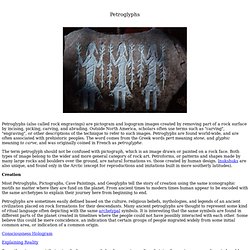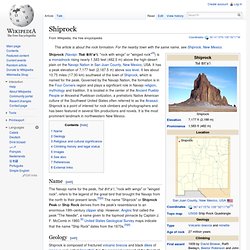

Anasazi Heritage Center. Petroglyphs Pictographs Cave Paintings Geoglyphs. Petroglyphs Petroglyphs (also called rock engravings) are pictogram and logogram images created by removing part of a rock surface by incising, picking, carving, and abrading.

Outside North America, scholars often use terms such as "carving", "engraving", or other descriptions of the technique to refer to such images. Petroglyphs are found world-wide, and are often associated with prehistoric peoples. The word comes from the Greek words pert meaning stone, and glyphic meaning to carve, and was originally coined in French as petroglyphe.
The term petroglyph should not be confused with pictograph, which is an image drawn or painted on a rock face. Creation Most Petroglyphs, Pictographs, Cave Paintings, and Geoglyphs tell the story of creation using the same iconographic motifs no matter where they are fund on the planet. Consciousness Hologram Explaining Reality Petroglyphs - Rock Art. Shiprock. Shiprock (Navajo: Tsé Bitʼaʼí, "rock with wings" or "winged rock"[4]) is a monadnock rising nearly 1,583 feet (482.5 m) above the high-desert plain on the Navajo Nation in San Juan County, New Mexico, USA.

It has a peak elevation of 7,177 feet (2,187.5 m) above sea level. It lies about 10.75 miles (17.30 km) southwest of the town of Shiprock, which is named for the peak. Governed by the Navajo Nation, the formation is in the Four Corners region and plays a significant role in Navajo religion, mythology and tradition. It is located in the center of the Ancient Pueblo People or Ancestral Puebloan civilization, a prehistoric Native American culture of the Southwest United States often referred to as the Anasazi. Shiprock is a point of interest for rock climbers and photographers and has been featured in several film productions and novels. Name[edit] Geology[edit] Map of Navajo Volcanic Field with Shiprock Religious and cultural significance[edit] Climbing history and legal status[edit] How to Make Pemmican - Pemmican Recipe. Welcome!

If you want to lose weight, gain muscle, increase energy levels or just generally look and feel healthier you've come to the right place. Here's where to start: Visit the Start Here and Primal Blueprint 101 pages to learn more about the Primal Lifestyle. Subscribe to my free weekly newsletter to receive 10 eBooks, a 7-Day Course of Primal Fundamentals, and more - all for free. Cut to the chase by visiting PrimalBlueprint.com. Thanks for visiting! Vihljamur Stefansson, eminent anthropologist and arctic explorer, went on three expeditions into the Alaskan tundra during the first quarter of the 20th century. Pemmican consists of lean, dried meat (usually beef nowadays, but bison, deer, and elk were common then) which is crushed to a powder and mixed with an equal amount of hot, rendered fat (usually beef tallow).
So, pemmican has a reputation as a sort of superfood. I got about a pound and a half of lean, grass-fed shoulder roast, let it firm up in the freezer, then sliced it thin. Stone weapons. Ötzi - South Tyrol Museum of Archaeology. OCCOQUAN PALEOTECHNICS LLC.® Ötzi the Iceman. Ötzi (German pronunciation: [ˈœtsi] ( ); also called Ötzi the Iceman, the Similaun Man, the Man from Hauslabjoch, Homo tyrolensis, and the Hauslabjoch mummy) is a well-preserved natural mummy of a man who lived around 3,300 BCE.[2][3] The mummy was found in September 1991 in the Ötztal Alps, hence Ötzi, near the Similaun mountain and Hauslabjoch on the border between Austria and Italy.[4] He is Europe's oldest known natural human mummy, and has offered an unprecedented view of Chalcolithic Europeans.

His body and belongings are displayed in the South Tyrol Museum of Archaeology in Bolzano, South Tyrol, Italy. Discovery Ötzi the Iceman while still frozen in the glacier, photographed by Helmut Simon upon the discovery of the body in September 1991 46°46′45.8″N 10°50′25.1″E / 46.779389°N 10.840306°E / 46.779389; 10.840306.[7] The province of South Tyrol therefore claimed property rights, but agreed to let Innsbruck University finish its scientific examinations.
Scientific analyses Body Blood.